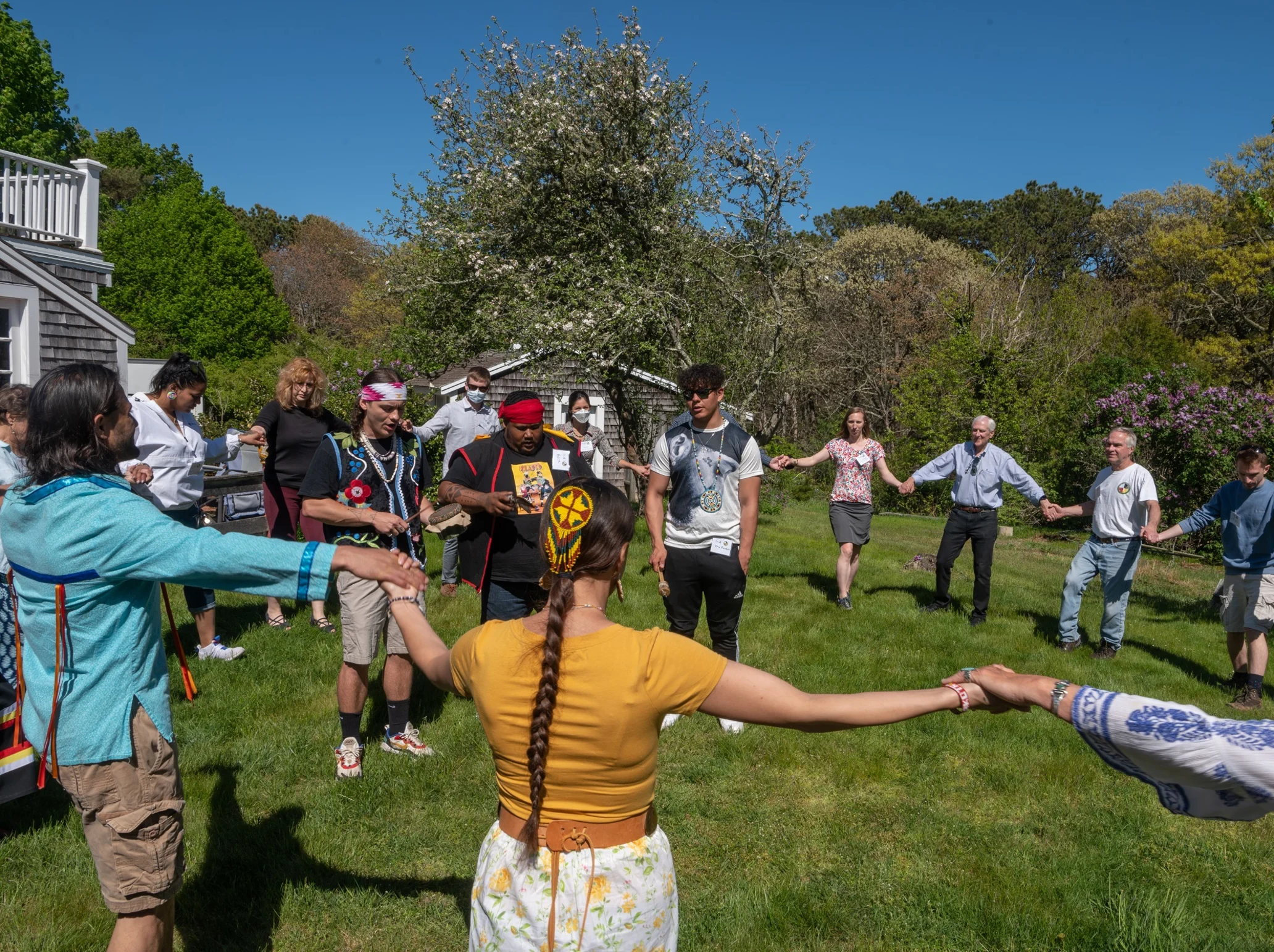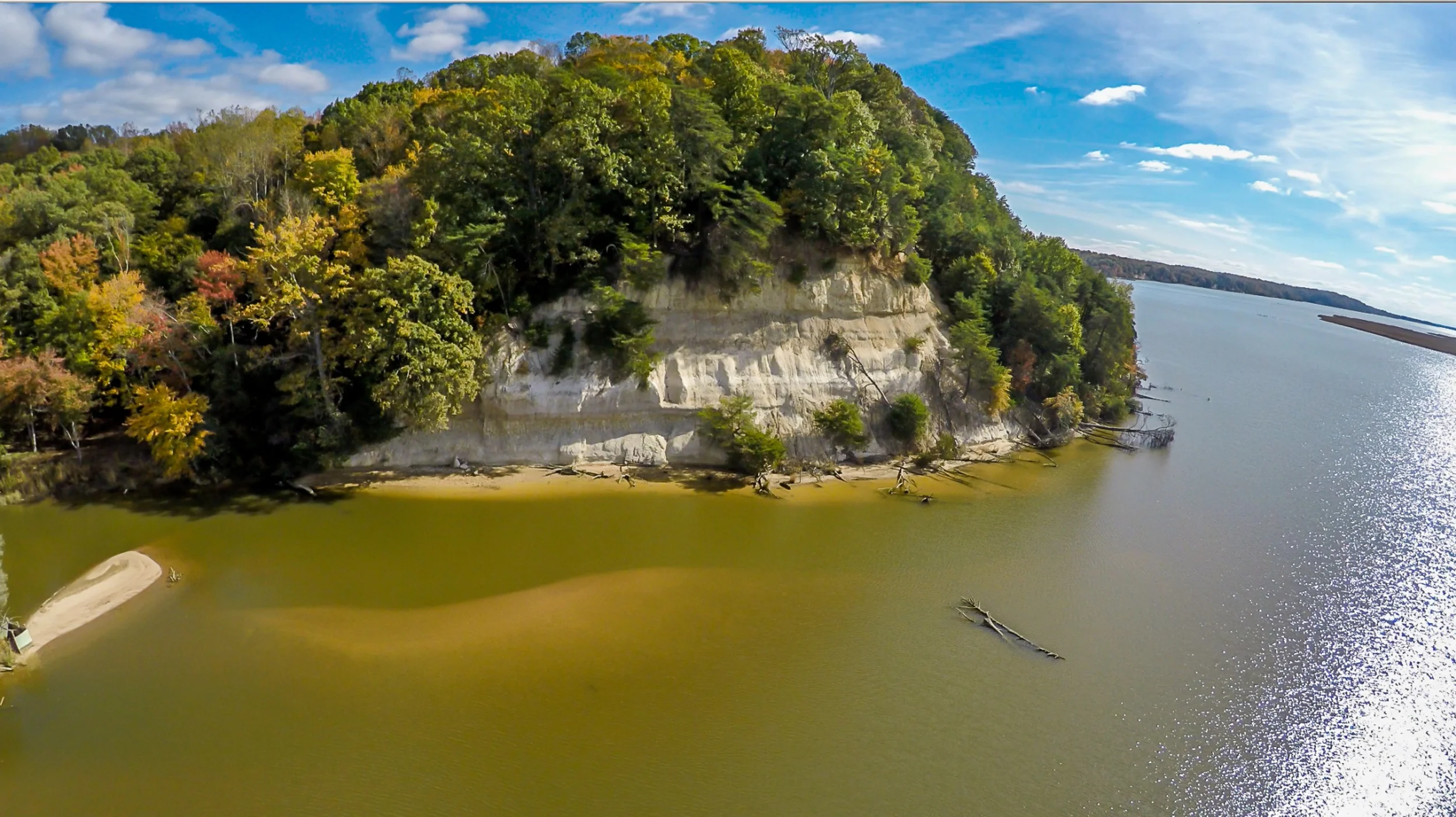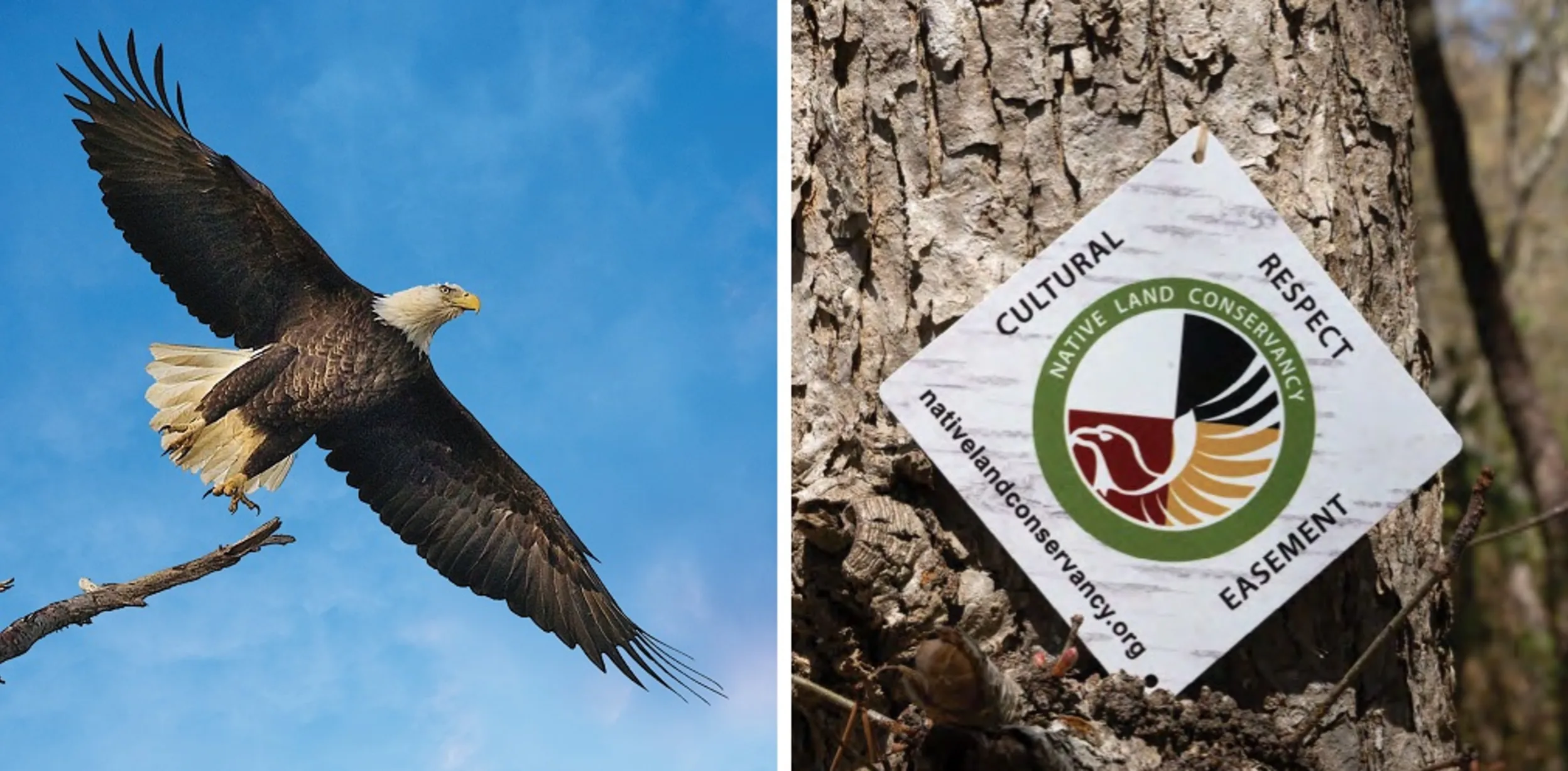Taking the long view
Indigenous tribes and land trusts work to build lasting collaborations.

“It was like being in a dream that came true,” said Rappahannock Tribal Chief Anne Richardson. “You work with your head down for so long, and then you look up and it’s there.”
The reality before Richardson was the return in April of stunning lands along the Rappahannock River in Virginia that were once part of the tribe’s ancestral homelands. More than 300 people came to celebrate the historic moment, including U.S. Secretary of the Interior Deb Haaland. Twelve years of concerted work by the tribe and numerous conservation partners led to the protection of this 465-acre property, where bald eagles gather throughout the year on a towering headland above the river. For tribal members, the restoration effort was actually 373 years in the making, since settlers stole their land and drove them inland, severing their bonds with the Rappahannock River.
A tribal village called Pissacoack, one of three along the river, once flourished on these cliffs.
“It’s just incredible to be able to go there and walk the land,” Richardson said. “You can see miles and miles up and down river. The spirituality and power you feel on those cliffs — it’s like an updraft of air that lifts you up.”

This collaborative work to build relationships and reconnect youth to the land represents a new wave of conservation that seeks to address historic injustices and achieve lasting change.
Return to the river
Young members of the Rappahannock Tribe, following generations of displacement from their ancestral river, were at risk of losing touch with the tools, plants, medicines and ceremonies integral to their lifeways. So tribal leaders launched a Return to the River program in 2016 designed to foster youth teamwork and leadership through time spent canoeing, fishing and camping.
The next year, with help from the Chesapeake Conservancy and the family of the late U.S. Senator John Warner of Virginia, the Rappahannock Tribe secured a 1-acre parcel close to the river, providing the fledgling youth program access to their ancestral lands.
That single acre was the first tangible step toward a 2,000-acre goal that Chesapeake Conservancy committed to pursue: helping restore land to the Rappahannock Tribe. In the 465-acre Pissacoack project that closed this spring, a generous family donation allowed the Conservancy to acquire the land, donating an easement to the U.S. Fish and Wildlife Service before transferring the deed to the tribe.
Working toward this ambitious goal has proven challenging, and a critical tract of riverfront land remains in limbo, threatened by plans to develop a luxury resort. Richardson now serves on the Conservancy’s board with its president and CEO, Joel Dunn, who she described as a “warrior,” persisting through setbacks. Dunn in turn draws inspiration from the tribe, noting “the perseverance the tribe has demonstrated to deal with and rise above challenges.”
Despite the project’s historic and ecological significance, Dunn says he lost count of the number of times he was told “no” when the Conservancy first sought major foundation grants. And the Rappahannock Tribe faced concerns that it might set up a casino, which Richardson dismissed. For the tribe, reconnecting with the land is the goal.
“To return my people to these ancient lands, these breathing entities, is like an umbilical cord for a baby,” she said.
The Rappahannock Tribe recently organized and hosted a Sovereign Nations of Virginia conference on Indigenous-led conservation at which Richardson and Dunn shared their model of collaboration. Plans are underway for a follow-up resource manual that tribes can use to learn the mechanics of returning lands to their ownership. Richardson seeks to establish an Intertribal Conservation Council in the watershed that could elevate the political impact of Indigenous people advocating for land protection.
“Tribes are going to become a major conservation force in the Chesapeake,” Dunn predicted.
Relationship-building on many levels
Relationship-building across boundaries — including the ones between species — is central to conservation work so we can “be together as a larger community,” saidRegina Lopez-Whiteskunk, cross-cultural programs manager at the accredited Montezuma Land Conservancy in southwest Colorado and a member of the Ute Mountain Ute Tribe. She sees her role, newly created last year, as “reaching beyond the arbitrary lines that divide us.” It is work, she added, that “should have happened a long time ago.”
Too often, according to Lopez-Whiteskunk, tribal recognition is confined to passing apologies or “Indigenous People’s Day” celebrations. She seeks “to help people understand it’s not just one day. It’s our lives.” Her primary work at MLC is to be a conduit of conversation, fostering communication between tribal and non-tribal community members. “When neighbors don’t talk to each other, that is not healthy,” she said.
Building relationships with the Ute Mountain Ute Tribe has helped MLC become “less linear and transactional,” noted Executive Director Travis Custer. He sees this reorientation as essential to the practice of environmental and social justice, and to address existential threats like the climate crisis and biodiversity. “We need to slow down and rethink our relationship to place,” he said.
Youth programs have been a good entry point for strengthening collaboration and community. Tribal youth now participate in MLC’s high school internship program, and several interns are working with the tribe’s biology department on a riparian restoration project. A steering committee that helps plan youth programs is working with a tribal leader, a tribal member and a tribal employee on collaborative design. The time they have committed to this work “speaks volumes to relationship-building over a year,” Lopez-Whiteskunk said. “It’s hard to get them to take time out.”

A gathering last fall brought together conservation staff and tribal elders to exchange stories of their connections to the land. People were able to “share from very, very sacred places,” Lopez-Whiteskunk recalled, allowing the non-Indigenous participants to better understand the heartbreak that tribal members have experienced from losing places they treasured for ceremonies and harvests.
To help address that loss, the Ute Mountain Ute Tribe recently received grant funding for a Traditional Harvest Project in which tribal members will inventory and assess current plant communities on the reservation, develop management plans to ensure sustainable harvests and work with MLC to connect with owners of conserved lands that might be available for cultural harvest.
Farmers and ranchers often allowed harvesting historically, but those informal agreements ended as land changed hands. “This project can be the start of rebuilding those family-to-family relationships,” Custer said, and potentially incorporating those rights into future conservation easements.
The project involves “relationship-building on so many different levels,” Lopez-Whiteskunk noted, such as helping tribal members restore their relationships to the plant communities and gathering stories of those plants from elders to share with youth.
Toward a new language of conservation
When the Native Land Conservancy in Massachusetts formed a decade ago, its founder and president Ramona Peters thought it would operate just like any other land trust, striving “to protect as much land as possible.” She soon discovered that being an all-Indigenous group made NLC an “oddity.”
“It took a while to build clarity,” Peters recalled. “What I needed to do was emphasize that we see all conservation groups as partners.”
NLC board members found that conservation language and policies rarely accounted for the needs of Native people. Many conservation narratives portray human beings as a “burden on wilderness” and define public access in ways that exclude Native rituals like plant harvests or ceremonies, Peters observed. “We need a new narrative that is honoring and welcoming of Indigenous people,” she said.
At the Alliance’s 2014 Rally, Peters met tribal representatives from California who shared the idea of creating “cultural respect easements,” legally binding agreements that ensure Indigenous people can enjoy traditional practices on conservation lands.
The first cultural respect easement in the eastern U.S. was signed in 2016, on a single preserve, and it grew from a partnership between NLC and the nearby Dennis Conservation Land Trust. Late last year, DCLT and NLC completed a legal agreement that ensures Indigenous access for traditional practices and ceremonies on all of DCLT’s preserves in perpetuity. “Now we can confidently send Native people out on the land,” Peters said.
NLC is working with Northeast Wilderness Trust, which owns a preserve adjoining the Wampanoag Common Lands (lands donated to NLC on behalf of all Wampanoag People), on the terms of a conservation restriction (easement) that NEWT will grant to NLC. Through the process, Peters has tried to “shift toward a language that breathes more life into the description of the land.” Deed language is typically “very cut-and-dried and cold,” she said, so it’s an ongoing challenge “honoring the life in this land in these documents.”
NLC has become adept at “using tools within the legal system,” noted Diana Ruiz, who became NLC’s first executive director last year, adding that the differing approaches to language reflect the different values and cultural identities of Indigenous and non-Indigenous people.
“You can’t change people’s values but through language and legal devices you can demonstrate yours,” she said. “Shifting ideologies takes a long time. If you want a sincere partnership, consider a long-term relationship-building approach.”
For tribal members who live off-reservation in Massachusetts and own their own properties, NLC is developing a Landowner Conservation Toolkit to help them continue holding and stewarding their lands in the face of escalating taxes.
NLC is stepping into a new sphere of long-term relationship building that includes holding easements for other all-Native groups. Working in partnership with a Maskoke community in Alabama, NLC expects to close this fall on an easement covering 650 acres that will belong to Ekvn-Yefolecv, an intentional ecovillage of Maskoke People whose ancestors were forcibly removed from their homelands 180 years ago. They have returned to revitalize their language and culture and practice natural building, regenerative agriculture and ecological restoration. Part of NLC’s new role will involve training local land managers.
The future depends on youth
This past summer, NLC worked in partnership with NEWT to supervise an intern from the Herring Pond Wampanoag Tribe.
“We view our role as giving him as many opportunities and experiences as we can,” Ruiz said. “He wants to bring his learnings back to his tribe.”
In Colorado, Lopez-Whiteskunk has already witnessed how time on the land is renewing young tribal members’ relationships with the natural world. Many of them are “taking the conversations home,” she said, prompting dialogue among families. “The biggest part of collaboration, and probably the best part, is working with the youth,” she says.
Back in Virginia, two Rappahannock youth will intern with FWS on lands adjoining the Pissacoack parcel, learning about land stewardship and refuge management, thanks to support from the William Dodge Angle, M.D., family. The tribe hopes that these youth will become leaders of the river programs.

The model of shared management and co-ownership emerging along the banks of the Rappahannock River is a “symbol of the change happening in the conservation movement,” Dunn said. Part of that transformation involves engaging more Indigenous young people in the work of land stewardship. “The future of conservation depends on engaging the youth of today,” he added.
Richardson hopes that younger tribal members will become a force going forward who can help “teach the traditional knowledge we know of conservation practices and spiritual beliefs to protect all the species.”